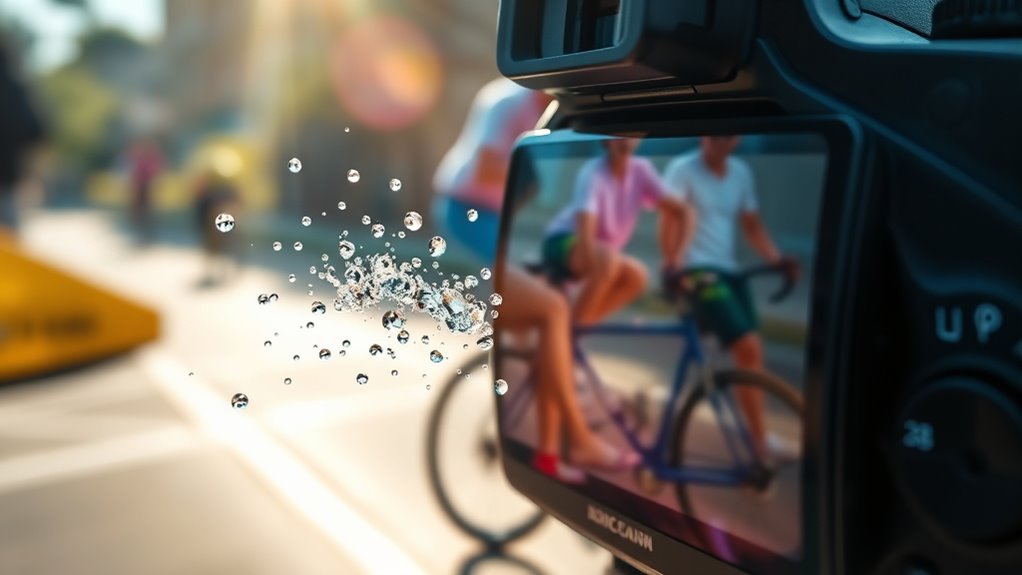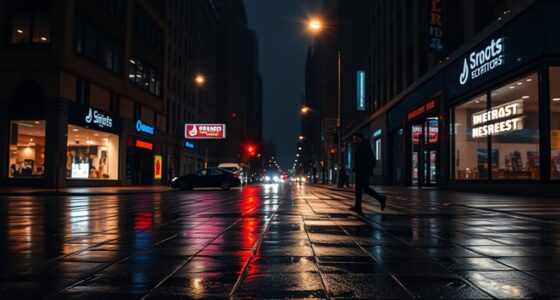Understanding the difference between shutter speed and frame rate is essential for capturing sharp, well-exposed footage with the right motion feel. Shutter speed controls how long your sensor is exposed to light, affecting motion blur, while frame rate determines how many frames you record per second, influencing smoothness. Properly balancing these settings guarantees your videos look natural and professional. Keep exploring, and you’ll discover how to optimize both for your creative goals.
Key Takeaways
- Shutter speed controls motion blur, while frame rate determines the fluidity of motion in video footage.
- Matching shutter speed to frame rate (e.g., 1/48s for 24 fps) creates natural-looking motion.
- Faster shutter speeds freeze motion; slower speeds introduce intentional motion blur for artistic effect.
- Frame rate affects overall smoothness, with higher rates producing more fluid videos, regardless of shutter speed.
- Properly balancing shutter speed and frame rate prevents unnatural motion and underexposed or overexposed footage.
Understanding the Basics of Shutter Speed and Frame Rate
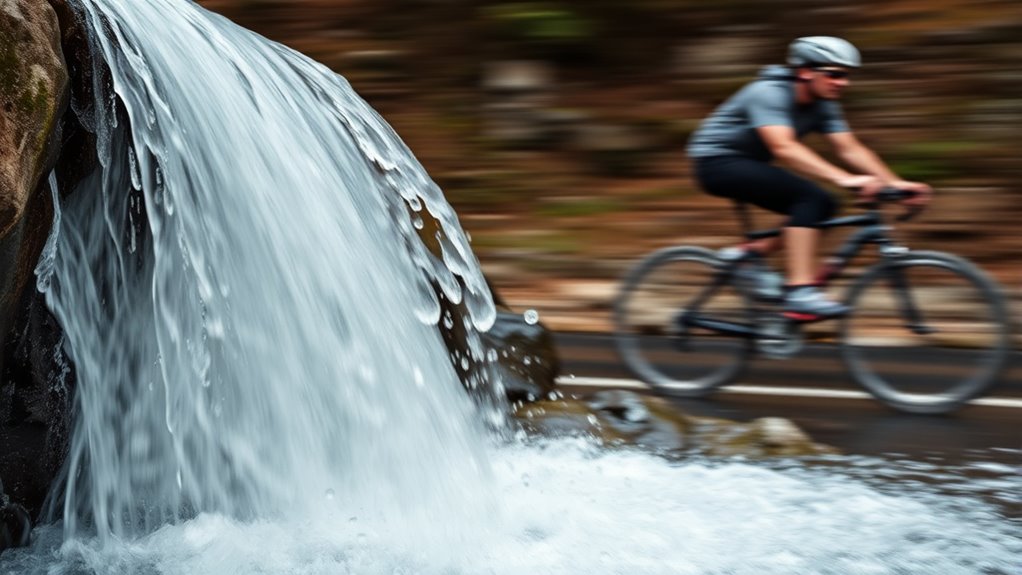
When it comes to capturing motion on camera, understanding the basics of shutter speed and frame rate is essential. Shutter speed determines how long your camera’s sensor is exposed to light, affecting motion blur and sharpness. Frame rate refers to the number of frames captured per second, influencing how smooth your video appears. Sensor sensitivity, or ISO, plays a role in how well your camera handles different lighting conditions; higher ISO can help compensate for faster shutter speeds but may introduce noise. Exposure compensation allows you to adjust brightness without changing shutter speed or ISO, helping you maintain proper exposure. Mastering these settings guarantees your footage is clear, well-exposed, and captures motion accurately, giving you greater creative control over your shots. Additionally, understanding projector specifications can help you optimize your setup for the best viewing experience.
How Shutter Speed Affects Motion and Image Sharpness
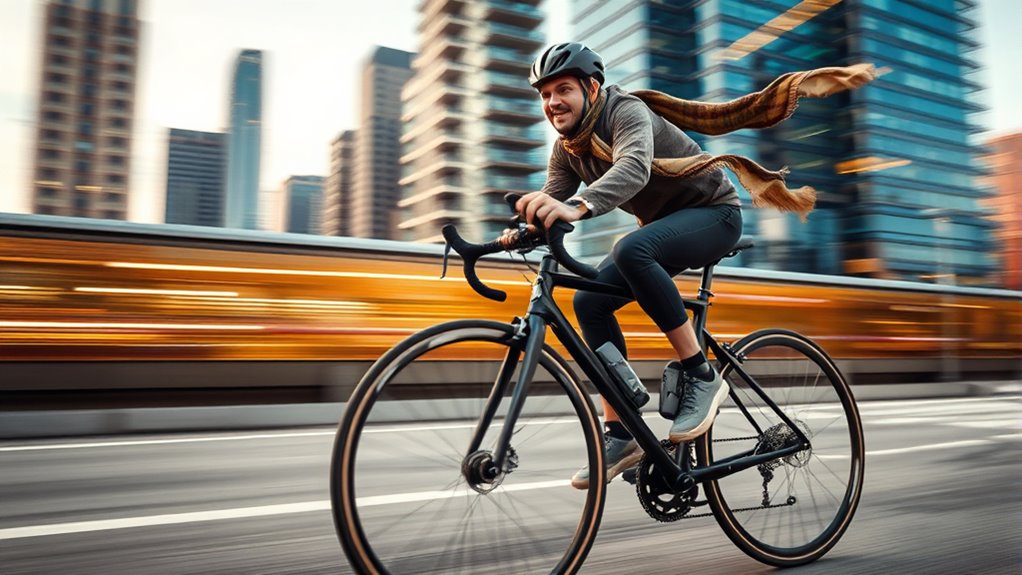
Shutter speed directly influences how motion appears in your footage. A fast shutter speed can freeze motion, capturing sharp images without blur, while a slow shutter speed introduces propagation blur, creating a sense of movement. When you use a slow shutter, moving objects may appear smeared, emphasizing motion but reducing sharpness. Conversely, a quick shutter speed minimizes propagation blur, making fast-moving subjects crisp and clear. Keep in mind:
Fast shutter speeds freeze motion sharply; slow speeds create intentional blur for dynamic effects.
- Slow shutter speeds create intentional motion blur for dynamic effects
- Fast shutter speeds achieve motion freezing, enhancing clarity
- Proper shutter settings prevent unwanted propagation blur
- Balancing shutter speed with scene movement is key to sharp footage
- Understanding how shutter speed relates to frame rate can help you achieve more cinematic results.
The Role of Frame Rate in Video Smoothness and Style

Frame rate plays a crucial role in determining how smooth or stylized your video appears. A high, consistent frame rate ensures fluid motion, creating a natural, cinematic look that feels seamless to viewers. Conversely, lowering the frame rate can introduce a choppy, vintage feel that adds character or mood to your footage. Maintaining frame rate consistency throughout your shoot prevents sudden jumps or flickering, which can distract your audience. The chosen frame rate also influences your stylistic choices; for example, 24 fps is widely used in filmmaking to evoke a cinematic aesthetic, while higher rates like 60 fps produce ultra-smooth action. Understanding how frame rate impacts both motion and style allows you to craft videos that align with your creative vision. Additionally, being aware of the impact of frame rate on the viewer’s perception can help you make more informed decisions for your project.
Common Mistakes When Mixing Shutter Speed and Frame Rate

Mixing shutter speed and frame rate without proper understanding can lead to noticeable issues in your footage. One common mistake is using a shutter speed too high or too low for the chosen frame rate, causing overexposure issues or unnatural motion. This often results in motion blur artifacts or overly sharp, choppy footage. Be cautious of:
- Relying solely on default settings without adjusting for lighting conditions
- Ignoring the impact of shutter speed on motion portrayal
- Mixing incompatible shutter speeds and frame rates that cause overexposure or underexposure
- Not testing settings beforehand, leading to inconsistent results
- Overlooking how natural motion can be affected by improper settings, resulting in footage that feels either too smooth or too jarring.
These errors can diminish the quality of your footage, making it look amateurish or distracting. Understanding the relationship between shutter speed and frame rate helps you avoid overexposure issues and achieve smoother, more professional results.
Tips for Choosing the Right Settings for Your Creative Goals
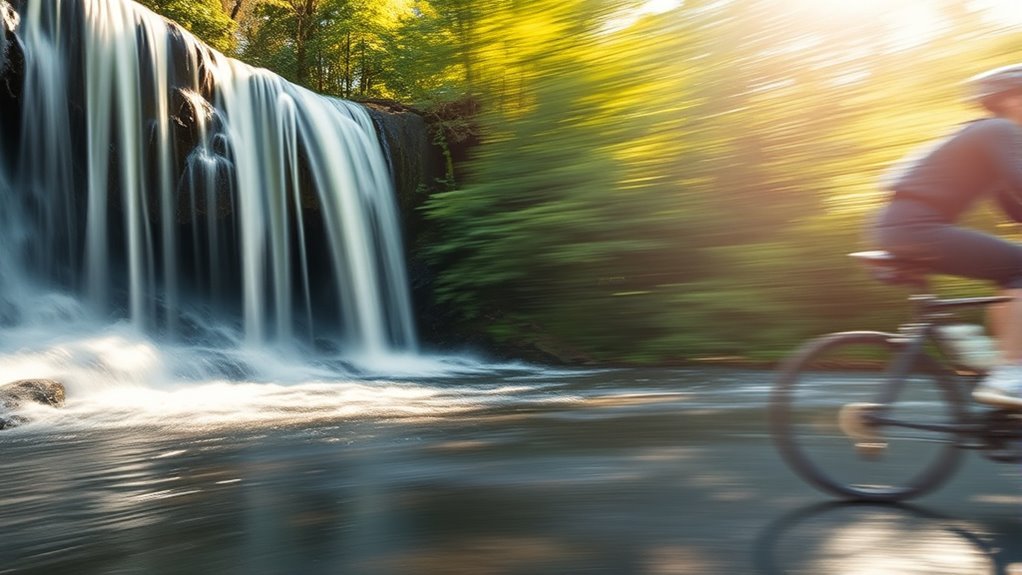
Choosing the right camera settings begins with clearly defining your creative goals. Consider how sensor sensitivity impacts your footage; higher ISO can brighten images in low light but may introduce noise. Adjust your shutter speed and frame rate based on your lighting conditions—bright environments allow for faster shutter speeds, preventing motion blur, while low light may require slower speeds and increased sensor sensitivity. Think about your desired effect: do you want sharp, crisp motion or a more cinematic, blurred look? Matching your shutter speed to your frame rate ensures natural motion, while understanding lighting conditions helps you balance exposure without sacrificing image quality. Additionally, understanding the effects of eye patches can help you manage fatigue and appearance, leading to more confident and relaxed on-camera performances. By aligning these settings with your vision, you’ll produce more intentional, professional-looking results.
Frequently Asked Questions
How Do Lighting Conditions Influence Optimal Shutter Speed and Frame Rate Choices?
Lighting conditions directly impact your shutter speed and frame rate choices. In low-light situations, you should use slower shutter speeds and adjust your aperture for more light, ensuring lighting consistency. Conversely, bright conditions allow faster shutter speeds and frame rates, preventing overexposure. Always monitor your lighting and make aperture adjustments accordingly, so your footage remains clear and well-lit regardless of changing lighting conditions.
Can Adjusting Shutter Speed and Frame Rate Affect the Perceived Emotion of a Scene?
Adjusting shutter speed and frame rate can markedly influence the emotion perception and viewer engagement of a scene. A fast shutter speed creates sharp, intense moments that heighten excitement, while a slower shutter adds a dreamy, emotional feel. Similarly, a higher frame rate smooths motion, making scenes more immersive, whereas a lower frame rate can evoke a nostalgic or tense atmosphere. You control how your audience emotionally connects through these settings.
How Do Different Camera Sensors Impact the Interplay of Shutter Speed and Frame Rate?
While exploring camera sensors, you’ll find that sensor compatibility and pixel size subtly influence how shutter speed and frame rate work together. Larger pixels often handle light better, allowing more flexibility in settings, while smaller pixels might require careful adjustments to avoid noise. Different sensors respond uniquely, so understanding your camera’s sensor type helps you optimize your shutter speed and frame rate for smoother footage and better image quality.
What Are the Best Settings for Slow-Motion or High-Speed Capture?
For slow-motion capture, set your shutter speed to double your frame rate to minimize motion blur and maintain sharpness. For high-speed shots, increase the shutter speed even more to freeze motion effectively. Use exposure control by adjusting ISO and aperture as needed, but prioritize shutter speed to guarantee crisp images. Keep in mind, faster shutter speeds reduce motion blur, delivering smooth, detailed slow-motion or high-speed footage.
How Do Post-Processing Techniques Alter the Effects of Shutter Speed and Frame Rate?
Post-processing effects like color grading can considerably change the look of your footage, highlighting details affected by shutter speed and frame rate. You can enhance motion blur or sharpness, creating a more dynamic or cinematic feel. Adjusting these elements during editing gives you control over the final outcome, letting you emphasize certain scenes or moods. By fine-tuning your footage, you shape the visual storytelling to match your creative vision.
Conclusion
Understanding how shutter speed and frame rate work together is like tuning a musical instrument—you get the harmony or dissonance you want. By mastering their interplay, you can craft videos and photos that truly stand out. Don’t be afraid to experiment and find what fits your style. With the right settings, your footage will flow smoothly, just like a well-played song, engrossing your audience with every shot.

